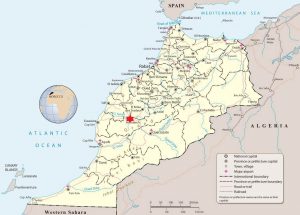Marrakesh
Marrakesh is the fourth largest city in Morocco. We have therefore visited all four of the largest cities – Casablanca, Fes, Tangier. It was inhabited by the Berbers in ancient times but the city was founded in 1062. Marrakesh grew rapidly and established itself as a cultural, religious, and trading center for the Maghreb and sub-Saharan Africa.
We stayed in a lovely Riad.
- our welcome tea
- courtyard
- looking down from our room
- looking across
We had a brief introduction to the Souk and The Square the first night. “The Jemaa el-Fnaa is one of the best-known squares in Africa and is the centre of city activity and trade. … It has been part of the UNESCO World Heritage site since 1985. The name roughly means “the assembly of trespassers” or malefactors. … Historically this square was used for public decapitations by rulers who sought to maintain their power by frightening the public. The square attracted dwellers from the surrounding desert and mountains to trade here, and stalls were raised in the square from early in its history. … Today the square attracts people from a diversity of social and ethnic backgrounds and tourists from all around the world. Snake charmers, acrobats, magicians, mystics, musicians, monkey trainers, herb sellers, story-tellers, dentists, pickpockets, and entertainers in medieval garb still populate the square.” (Wikipedia) We saw some of this but very difficult to take photos.
- carving brass
- carving wood
- painting
- crowds
- music
Our two days in Marrakesh were packed with seeing many places. We started with the Koutoubia Mosque, the largest mosque in the city. It was built 1184-1199. The Kasbah Mosque was originally built by the Almohad caliph Yaqub al-Mansour in 1185-1190. It is located in the old kasbah of Marrakech. Along with the Koutoubia Mosque, it is one of the most important historical mosques in Marrakech.
- minaret
- tombs
- architecture
- mosaics
- carving
The Bahia Palace, set in extensive gardens, was built in the late 19th century by the Grand Vizier of Marrakesh, Si Ahmed ben Musa. Bou Ahmed resided here with his four wives, 24 concubines and many children. It is a beautiful place with extensive rooms.
- ceiling
We visited the beautiful “Museum of Confluences.” It had been a majestic palace built in 1910 and used as a residence. It is now brings together many of the influences of Moroccan culture and architecture. When we visited they had a special exhibit of the influence of Yves Saint Laurent. (Later we visited a special museum of Yves Saint Laurent’s work but no photos inside were allowed.)
- “making sense”
Of course we visited the souk!. It is always the heart and soul of the town.
- herbs
- roof of lane
- herbs drying
- carriages waiting
- transport
We took a carriage ride to the Majorelle Garden. It had been the home of landscape painter Jacues Majorelle. Fashion designer Yves Saint Laurent bought and restored the property and has a memorial to him. The garden has a large collection of plants from five continents including many cacti, palms and bamboo. It was a welcomed cool relief in the heat of Marrakesh.
We visited the old Jewish Quarter (Mellah). During the 16th century, the Mellah had its own fountains, gardens, synagogues and souks. Until the arrival of the French in 1912, Jews could not own property outside of the Mellah; all growth was consequently contained within the limits of the neighborhood, resulting in narrow streets, small shops and higher residential buildings. The Alzama Synagogue is located in the area.
- home of rabbi
- balcony
- synagogue
- mosaic
- narrow street
Our last afternoon we went to The Secret Garden to relax and enjoy a lovely lunch. It is a quiet spot with examples of Islamic art and architecture.
- The Secret Garden
- courtyard
- looking down from terrace
- lunch
In the evening we had a Farewell Meal at a luxury restaurant. We said good-by to most of the other travelers. Only six of us are continuing on the post-trip to Essaouira and Casablanca.































































